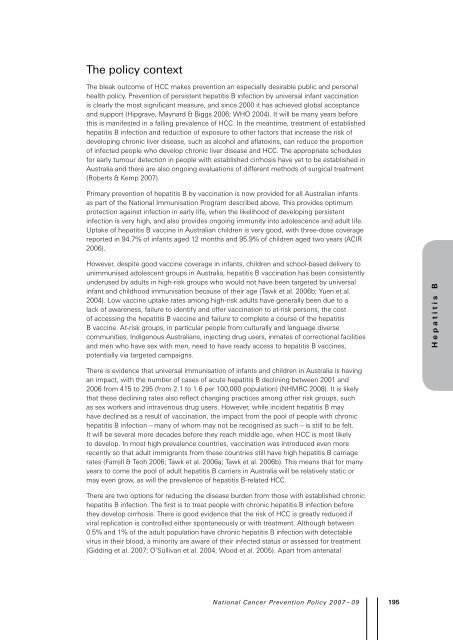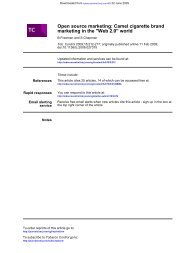National Cancer Prevention Policy - Tobacco Control Supersite
National Cancer Prevention Policy - Tobacco Control Supersite
National Cancer Prevention Policy - Tobacco Control Supersite
Create successful ePaper yourself
Turn your PDF publications into a flip-book with our unique Google optimized e-Paper software.
The policy context<br />
The bleak outcome of HCC makes prevention an especially desirable public and personal<br />
health policy. <strong>Prevention</strong> of persistent hepatitis B infection by universal infant vaccination<br />
is clearly the most significant measure, and since 2000 it has achieved global acceptance<br />
and support (Hipgrave, Maynard & Biggs 2006; WHO 2004). It will be many years before<br />
this is manifested in a falling prevalence of HCC. In the meantime, treatment of established<br />
hepatitis B infection and reduction of exposure to other factors that increase the risk of<br />
developing chronic liver disease, such as alcohol and aflatoxins, can reduce the proportion<br />
of infected people who develop chronic liver disease and HCC. The appropriate schedules<br />
for early tumour detection in people with established cirrhosis have yet to be established in<br />
Australia and there are also ongoing evaluations of different methods of surgical treatment<br />
(Roberts & Kemp 2007).<br />
Primary prevention of hepatitis B by vaccination is now provided for all Australian infants<br />
as part of the <strong>National</strong> Immunisation Program described above. This provides optimum<br />
protection against infection in early life, when the likelihood of developing persistent<br />
infection is very high, and also provides ongoing immunity into adolescence and adult life.<br />
Uptake of hepatitis B vaccine in Australian children is very good, with three-dose coverage<br />
reported in 94.7% of infants aged 12 months and 95.9% of children aged two years (ACIR<br />
2006).<br />
However, despite good vaccine coverage in infants, children and school-based delivery to<br />
unimmunised adolescent groups in Australia, hepatitis B vaccination has been consistently<br />
underused by adults in high-risk groups who would not have been targeted by universal<br />
infant and childhood immunisation because of their age (Tawk et al. 2006b; Yuen et al.<br />
2004). Low vaccine uptake rates among high-risk adults have generally been due to a<br />
lack of awareness, failure to identify and offer vaccination to at-risk persons, the cost<br />
of accessing the hepatitis B vaccine and failure to complete a course of the hepatitis<br />
B vaccine. At-risk groups, in particular people from culturally and language diverse<br />
communities, Indigenous Australians, injecting drug users, inmates of correctional facilities<br />
and men who have sex with men, need to have ready access to hepatitis B vaccines,<br />
potentially via targeted campaigns.<br />
There is evidence that universal immunisation of infants and children in Australia is having<br />
an impact, with the number of cases of acute hepatitis B declining between 2001 and<br />
2006 from 415 to 295 (from 2.1 to 1.6 per 100,000 population) (NHMRC 2008). It is likely<br />
that these declining rates also reflect changing practices among other risk groups, such<br />
as sex workers and intravenous drug users. However, while incident hepatitis B may<br />
have declined as a result of vaccination, the impact from the pool of people with chronic<br />
hepatitis B infection—many of whom may not be recognised as such—is still to be felt.<br />
It will be several more decades before they reach middle age, when HCC is most likely<br />
to develop. In most high prevalence countries, vaccination was introduced even more<br />
recently so that adult immigrants from these countries still have high hepatitis B carriage<br />
rates (Farrell & Teoh 2006; Tawk et al. 2006a; Tawk et al. 2006b). This means that for many<br />
years to come the pool of adult hepatitis B carriers in Australia will be relatively static or<br />
may even grow, as will the prevalence of hepatitis B-related HCC.<br />
There are two options for reducing the disease burden from those with established chronic<br />
hepatitis B infection. The first is to treat people with chronic hepatitis B infection before<br />
they develop cirrhosis. There is good evidence that the risk of HCC is greatly reduced if<br />
viral replication is controlled either spontaneously or with treatment. Although between<br />
0.5% and 1% of the adult population have chronic hepatitis B infection with detectable<br />
virus in their blood, a minority are aware of their infected status or assessed for treatment<br />
(Gidding et al. 2007; O’Sullivan et al. 2004; Wood et al. 2005). Apart from antenatal<br />
<strong>National</strong> <strong>Cancer</strong> <strong>Prevention</strong> <strong>Policy</strong> 2007 – 09<br />
1 5<br />
H e p a t i t i s B




